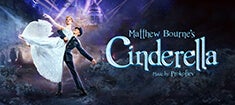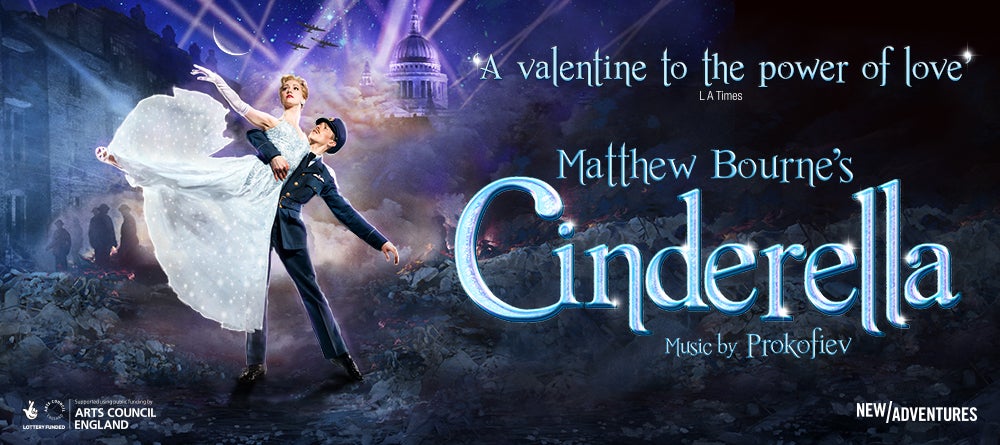
Sweeping Cinderella From the Ball to the Blitz
On Friday, January 4, we hosted an open conversation with Matthew Bourne about Cinderella, moderated by Charlotte Ballet Artistic Director Hope Muir. Read on to learn more about this production, running January 6-12 at Belk Theater.
Hope Muir: You mentioned Cinderella coming on the back end of Swan Lake, '97, and also just before The Car Man. And I'm to understand you've revisited Cinderella a bit...
Matthew Bourne: A lot, actually.
HM: The version in '97, how different will it be to watch we see in Charlotte on Sunday?
MB: Very different, actually, and it all happened a while ago. We did it straight into the West End when we first did it. We had a much bigger cast. We had guest stars in it...so when I got the chance to revive it -- it was about 15 years ago or something -- we really reworked it substantially. Redesigned, rethought a lot of it, recast it in a way that worked for us for tour-ability. It really needed a lot of work to make it the show it is now. I'm so sort of happy with what it is now. I just feel that the story we're telling now and the feeling of the piece is much closer to what I was after initially.
"I could almost hear the bombs dropping, I could feel the idea of escapism in this score. I could feel the idea of some sort of underlying darkness where the magic breaks through and this feeling of hope through difficult circumstances."
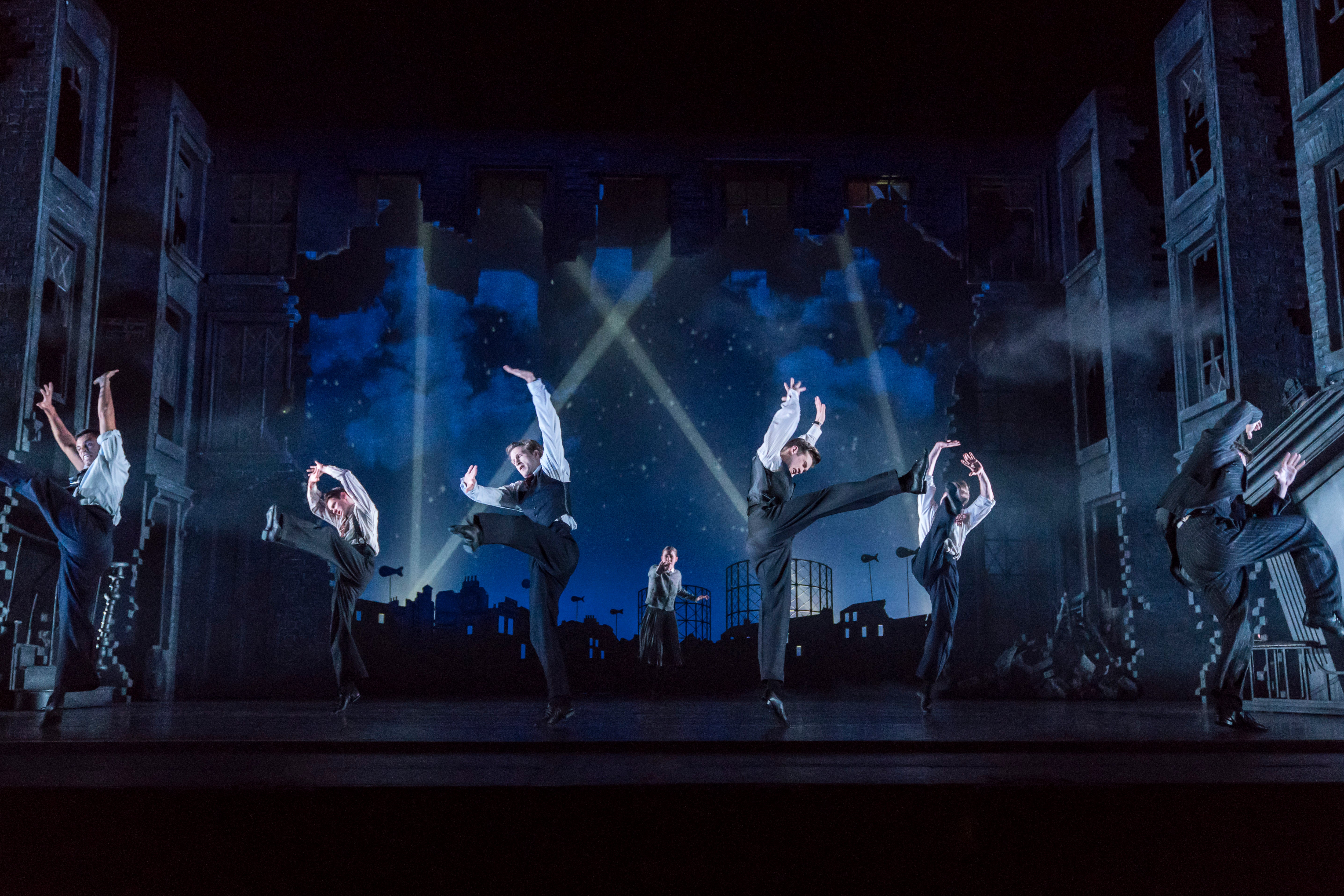
HM: The setting of Matthew's Cinderella is London, World War II. We're moving away from the traditional setting; why?
MB: Well, two things. One was obviously I was looking, having just done Swan Lake, and I loved this score, the Cinderella score. I grew up watching the Fred Ashton version, and I fell in love with this music, which is extraordinary. So I wanted to work with it, but I had to think of something different, some different way of doing it. And in my research about the piece, I discovered that Prokofiev, who wrote the score, wrote this score during the Second World War, and it was premiered at the Bolshoi I believe just after the war in 1946 and then in London, the Ashton version, in 1948. But he wrote it during this time, and I thought Well, that's really interesting. Why don't I listen to it with those ears? Listen to the score again with the ears of that period, and what I heard was a filmic score of the 1940s, a very good one.
But also I could almost hear the bombs dropping, I could feel the idea of escapism in this score. I could feel the idea of some sort of underlying darkness where the magic breaks through and this feeling of hope through difficult circumstances. And then I started to think of aspects of the Cinderella story, like people falling in love very quickly, "dance tonight we may or die tomorrow," the image of a shoe in the rubble – the glittery shoe in the rubble of the bombed building – it all sort of came together. A heroine who is a movie fan, she loves movies, basically the idea of escapism, very strong Cinderella thing.
But it also ended up being a story about very ordinary people. She imagined herself as a movie star, the guy she meets who is the prince figure is a sort of wounded airman. She sees him as a heroic film star almost, a heroic figure. It turns out they’re actually quite similar, quite ordinary people just falling in love. And for me, that’s what’s very touching about the piece; it’s one of many wartime stories. But the second thing I was going to say about why, is my parents both grew up in London during the Blitz and of course my grandparents. They were not evacuated as many young people were. So I spent a lot of my early years being told stories about that time. And actually four of the characters in the piece are named after my grandparents. So it’s a very personal, sort of family connection to that era and that period, and being a Londoner myself as well.
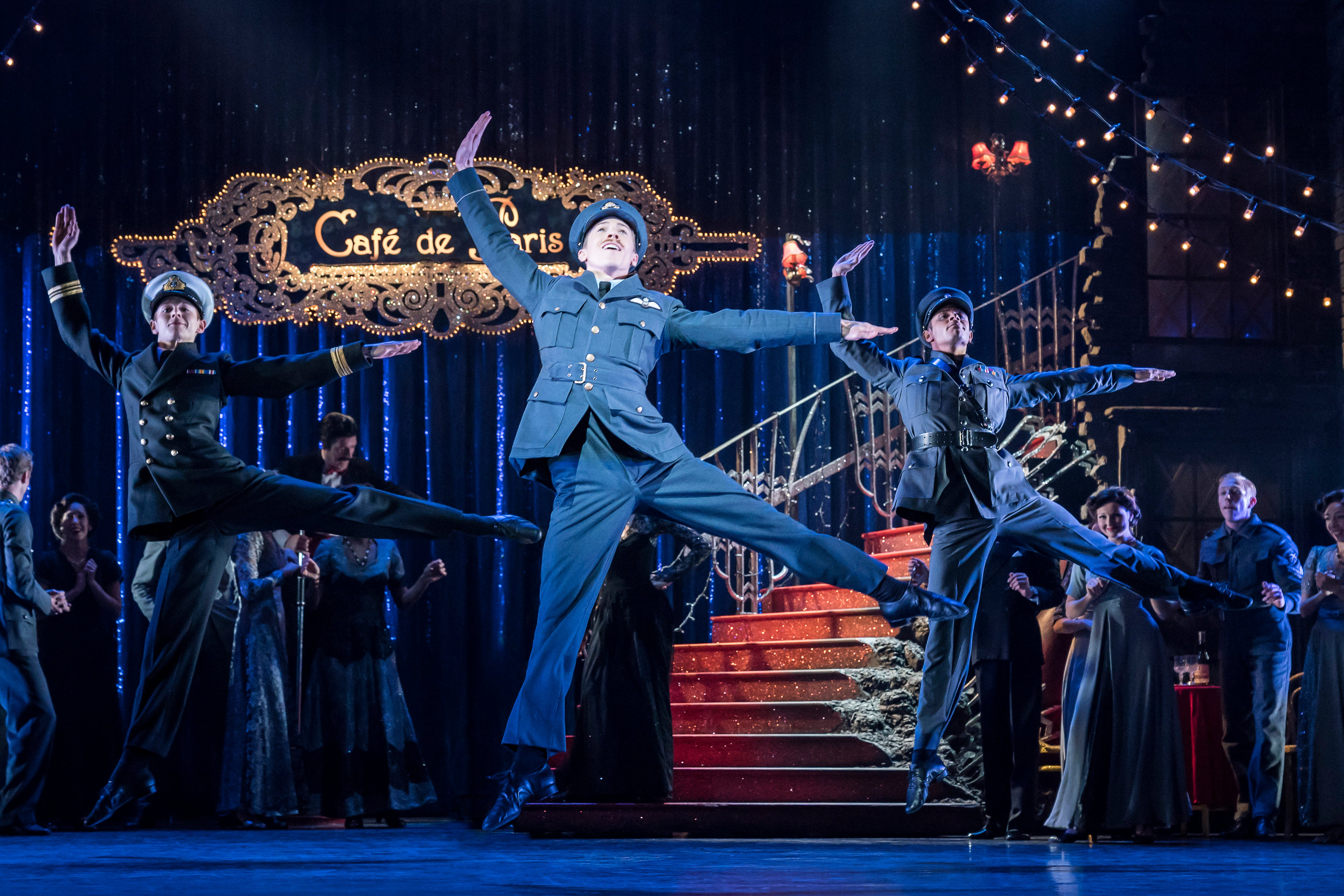
HM: Speaking of the Prokofiev score, I find it one of the darker scores. When you think about possibly cutting some of the music or cutting something out or jumping ahead to propel the narrative, how do you make those decisions?
MB: Well, I can tell you a story about that one on this piece. It’s quite interesting. So when we first did the piece, we got permission from the Prokofiev estate. And the Prokofiev family, part of the family lived in London. The artist son of the famous composer, Prokofiev’s son, was alive at that time – Oleg Prokofiev – and he was an artist. He asked if he could come in and draw the dancers while we were rehearsing, so I was completely intimidated about cutting any of the music. I’m the first person ever, I think, to choreograph the whole three acts in the right order. The Ashton version cuts lots and every version cuts something. I’ve since that time cut a few bits and reordered a few bits to make the story work better. But I did do the entire music from beginning to end.
But there’s a nice little anecdote following that. This year when we revived the piece, the son of the son came – he’s called Gabriel Prokofiev, he’s also a composer now. They found some of the drawings their father had done during rehearsals and had framed them for me. So they gave me this gift which is a direct connection to Prokofiev with the drawings his son did of this piece. So it’s a lovely, lovely gift and I was very touched by them.
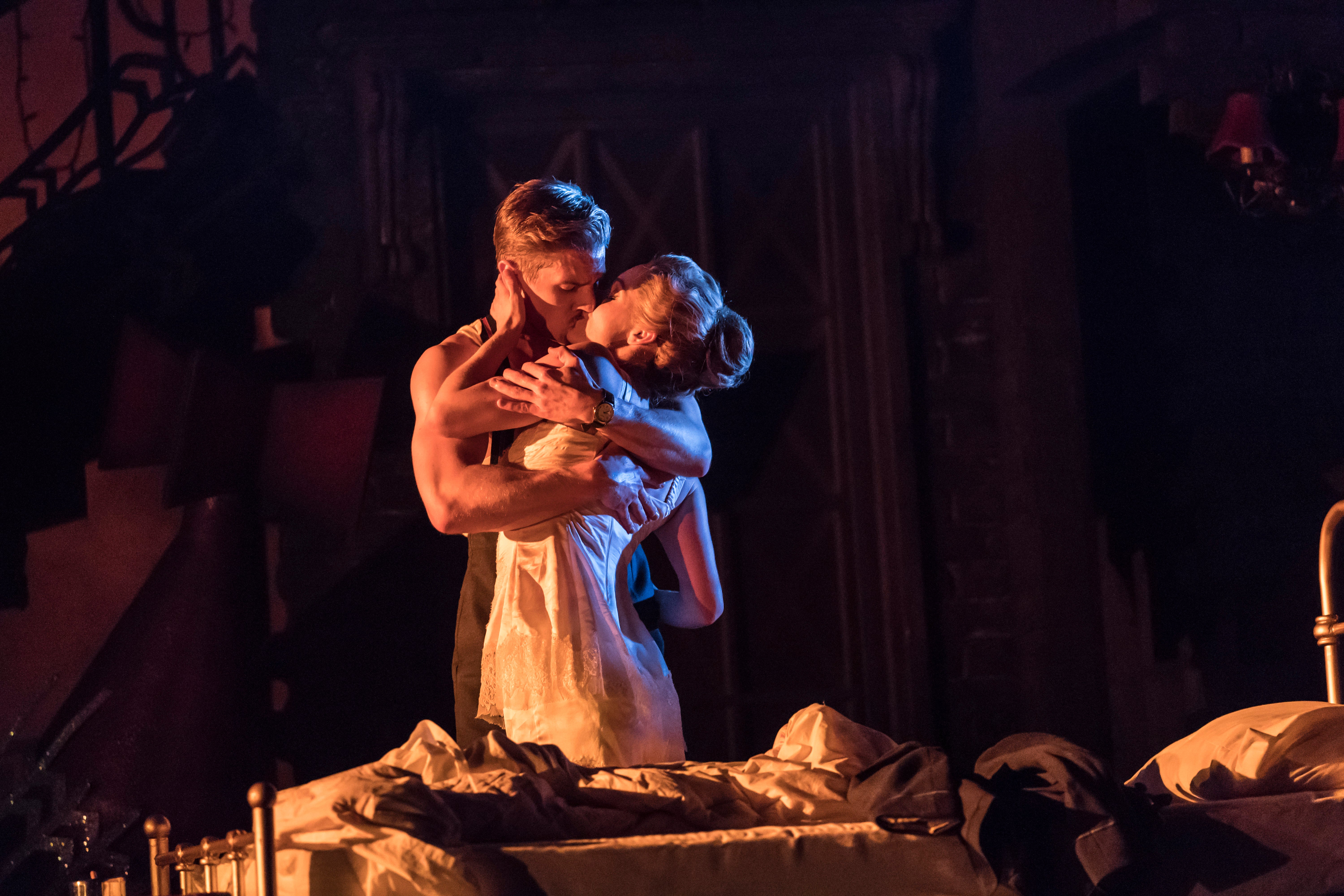
HM: One of the things, personally, that I think makes Matthew’s work so strong is his real commitment to character development. And having worked on Highland Fling, the Scottish ballet, and seen first-hand the amount of research and the amount of attention he demands of the dancers to really invest in those stories. Before we start talking about some of the new characters in Cinderella that you’ve introduced, I’d just like it if you could perhaps share that research and how much you really ask of the dancers.
MB: I do expect them to do a lot of their own research and bring something to the table when making a piece, even if it’s a piece that’s been done before that they have their own ideas that they can bring to it. It’s something that I learned from working in theatre as well as dance – I worked with some great theatre directors early on in my career; I worked with Trevor Nunn, I’ve worked with Sam Mendes...a lot of great directors more senior to me, senior directors. I learned from Trevor in particular that there are no small parts in a play or a musical, that everyone has to have a life history. So if you’re a maid who comes on, has one line and then goes off, he wants to know everything about that person. You have to come up with the character. So I do that with my dancers. Why are they in this story? Why are they there? Lots of background information that makes them a real, fully-formed person when they come on in character. Some of them go into enormous detail for this and enjoy it very much. It’s a different way of working. But it does give you a richness and also what happens particularly when you’re creating a new piece, when you’re dealing with your main characters and you’re trying to work out a new scene that’s got a lot of people in it, they will come up with material around the edges of the main material that is interesting and relevant because they know who they are. My character would do this. So they take care of themselves in an interesting way; you don’t have to tell them everything. They know what they might do. And if you say something’s a shock moment in the piece and everyone has to react, they can think well, how does this person react? Not oh, I’ve just got to go [surprised face] or something. You know, a lot of ballets require you to be happy or sad. And dancers are very good at smiling and looking concerned or a bit sort of wayward.
HM: Acting is action.
MB: And the physicality as well. So with dancing, there’s so much you can say with how you walk, how you sit, your stance, all those things that we work on. And that creates character as well.
"What people wanted to see was Cinderella by a fireplace, two sisters looking a bit grumpy and her with a broom, sweeping. And that’s what we give you now."
HM: So speaking of characters, in Cinderella there are a few other characters that are unexpected. Do you just want to explain a bit about the family and the fairy godmother?
MB: Yes, she’s got quite a big stepfamily in this version. People have often asked me why? One of the things we did when we first did the piece…in our version, she’s got two sisters, as usual, she also has three stepbrothers. There’s a father, who is an invalid and there is the stepmother. So initially, when we first did it, audiences were very confused. What is going on? I realized after a while with this piece…what people wanted to see was Cinderella by a fireplace, two sisters looking a bit grumpy and her with a broom, sweeping. Audiences needed to see the stepsisters, Cinderella with a broom. And that’s what we give you now. After a little bit of intro, the first scene, that’s what you get. And then we introduce the brothers and you think oh the family’s a bit bigger. But everyone’s happy.
Again, it was done for practical reasons. It’s interesting how things come about. We’d just done Swan Lake. I had a lot of dancers who’d been very successful in that piece, who’d played the prince, and I needed nice roles for everyone in my company. I’ve very good like that. I like to look after people. So I created all these roles for the dancers that I had, and I needed more male roles. So that’s what I did.
But it’s turned out to be more interesting, you’ve got all these different personalities and they add something. And all the family, the sisters and the brothers, have boyfriends and girlfriends as well, so they all come into the scene, so you’ve got even more characters to get to know so be ready for it. Lots of characters coming your way. But it’s part of creating a world of different people, different types of people.
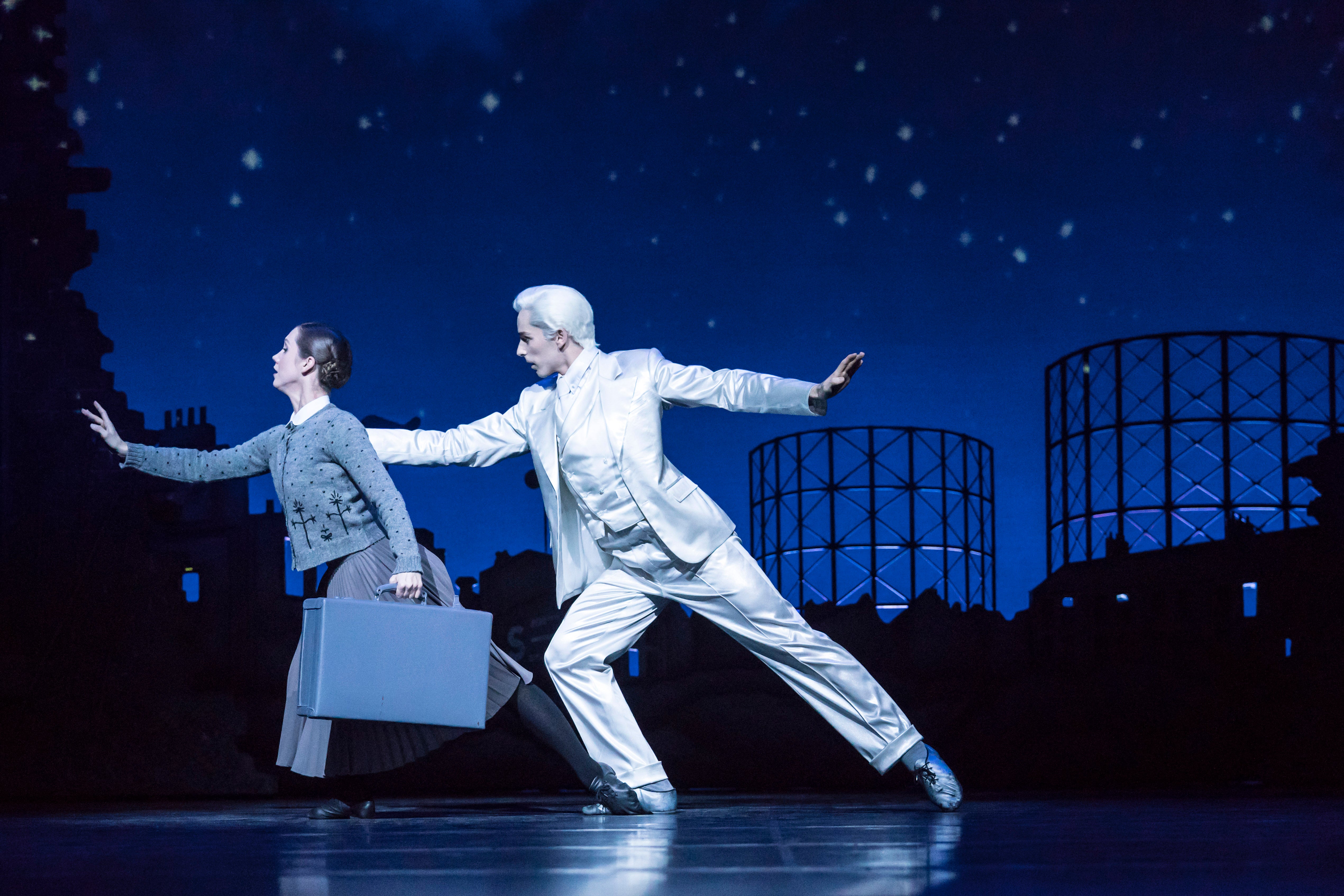
The fairy godmother figure in this version is played by a man. He’s not a man in a big dress. He’s a male angel. He’s like a guardian angel, inspired by several films like It’s a Wonderful Life, A Matter of Life or Death – I think it was called Stairway to the Stars here – and another film where Cary Grant was an angel, The Bishop’s Wife. Cary Grant was the sort of thing that we thought of in a way, Carey Grant as an angel. So he’s an angel without wings but he has a kind of shiny suit on, and you know he’s from another world. He’s ethereal in some ways. But I actually thought the idea of a male guardian angel looking after this young girl was a nice thing; it worked better for me that he took us through the story. But what became interesting about him as a character, he didn’t just appear for the good. He appears to be more of a fate figure. Sometimes bad things happen that he seems to instigate as well.
It’s the journey she has to go on to find love, really, and it’s not all plain sailing. Life isn’t all plain sailing. He is this fate figure that takes her through, guides her, helps her through these things and eventually…well, I won’t give it away.
"She is someone who fights for what she wants."
HM: And Cinderella, she’s quite feisty.
MB: She is. She’s a girl, as in the story, who is treated a bit like a servant by her family, her stepfamily. But she is someone who fights for what she wants. She’s got a wild imagination; she’s a girl with a great imagination through movies and things that she’s been to see. And she imagines herself as things. She fantasizes about who she could be, which I think is lovely. The whole central premise of the piece, the whole ball scene, is all in her imagination. It’s how she sees herself in her dreams. But she gets this knockback in Act III where she’s not that person; she’s an ordinary girl. It’s quite a journey she goes on.
HM: It’s quite nice that she’s not portrayed as a victim, and she’s also not looking to be saved, which I find quite refreshing.
MB: I agree with you. It feels it could be that way all the way through the piece a little bit. It feels it could go that direction, but you realize in Act III that the guy that she’s fallen in love with is very much her equal. They’re equals that come together. They’re very similar to each other. And they seem perfect together. And that’s what I was trying to say with it. It always touches me, particularly this music is amazing in the piece.
"I always find it difficult talking about my style. I think people would think it’s very much in the style of what I do, which is storytelling with a big vision and quite a spectacular vision."
HM: Just in comparison to [2017’s] production of The Red Shoes, apart from the shoes, any other things that might be similar?
MB: Well, a lot of the same company to be honest. A lot of the same people that people may have seen in The Red Shoes. Ashley Shaw, who is one of our two Cinderellas, was one of our two Vickie Pages in The Red Shoes. Ashley won the Critics Circle Award as Dancer of the Year in a Modern Piece for Red Shoes. She’s also nominated this year for this piece, so two years running she’s been nominated for Best Performance.
But similarities…I don’t know. I always find it difficult talking about my style. I think people would think it’s very much in the style of what I do, which is storytelling with a big vision and quite a spectacular vision. Red Shoes is one of my most spectacular pieces; I think this matches it in many ways. It’s amazing that we can bring this production to you, actually. It’s such a big production in terms of sets and costumes and wigs. It’s a big show all the way from the UK. It’s amazing and wonderful that we’re here and that we can bring it to Charlotte. I think it’s what people expect from me now. They expect a big narrative sweep, something that’s going to move them and make them laugh a little but also be a spectacle and epic story.
